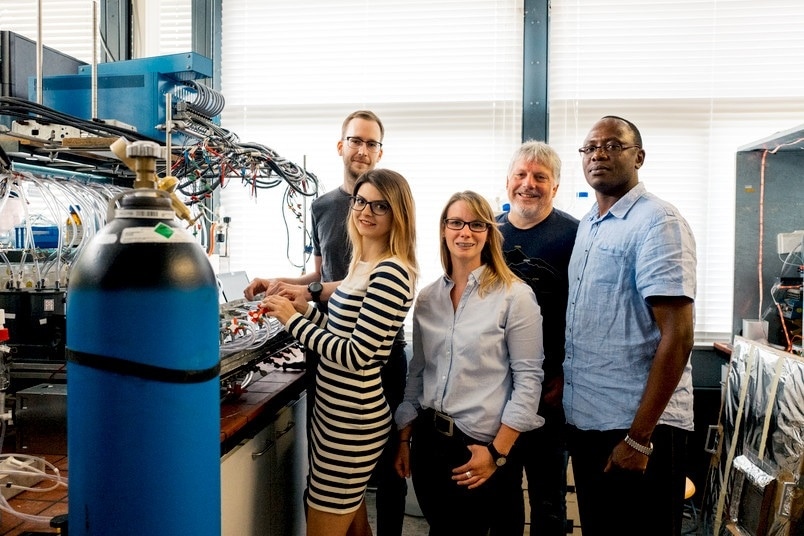Jul 3 2017
A new method to firmly fix catalyst powders on electrode surfaces has been developed by Chemists at Ruhr-Universität Bochum. Presently, the application of powder based catalysts is being hampered by high physical stress induced on catalyst films by gas evolving reactions.
The new technique is potentially vital for hydrogen production by water electrolysis. A report on this has been presented in the international edition of Angewandte Chemie by a team made up of Dr Corina Andronescu, Stefan Barwe and Prof Dr Wolfgang Schuhmann from the Center for Electrochemical Sciences.
 The team at the Center for Electrochemical Sciences at Ruhr-Universität Bochum: Stefan Barwe, Dr Corina Andronescu, Sandra Möller, Prof Dr Wolfgang Schuhmann and Dr Justus Masa (from left to right). The home-made apparatus shown in the background allows the scientists to simultaneously explore the long-term stability of up to ten catalysts without blocking the infrastructure for other measurements. (C) RUB, Kramer
The team at the Center for Electrochemical Sciences at Ruhr-Universität Bochum: Stefan Barwe, Dr Corina Andronescu, Sandra Möller, Prof Dr Wolfgang Schuhmann and Dr Justus Masa (from left to right). The home-made apparatus shown in the background allows the scientists to simultaneously explore the long-term stability of up to ten catalysts without blocking the infrastructure for other measurements. (C) RUB, Kramer
Catalyst syntheses often aim for nanoparticles in order to achieve a high surface area.
Prof Dr Wolfgang Schuhmann, the Center for Electrochemical Sciences
However, stable and tight fixation of nanopowders on electrodes still continues to be challenging. Appropriate catalyst binders are available for electrodes used in acidic media. Such binders are mostly used in alkaline environments due to the lack of ideal alternatives. However, a key disadvantage of employing these binder materials in alkaline electrolytes refers to the fact that they are electrically insulating and fundamentally unstable, thus majorly hindering the application of several greatly active and potentially industrially interesting powder catalysts.
Polymer transforms into carbon
The team from Bochum has set out a new method for tight powder catalyst fixation on metal surfaces. The Researchers used a particular organic polymer, namely polybenzoxazine, which is capable of changing to carbon at temperatures around 500 °C. The team applied the polymer together with the powder catalyst on the surface of a nickel electrode and then subsequently heated it at high temperatures. The thermal treatment allowed the polymer to change into a carbon matrix embedding the powder catalyst particles.
The distinctiveness was the choice of the used polymer. Polybenzoxazines are highly thermal stable and show near-zero shrinkage at higher temperatures. They carbonize giving high residual char in the absence of oxygen.
Easy to produce
We expect that the presented method might also be applicable at an industrial scale, although this is yet to be validated. However, the necessary procedures are already well established. A mixture of catalyst and polymer could be sprayed on an electrode surface, which is then transferred into an oven.
Prof Dr Wolfgang Schuhmann, the Center for Electrochemical Sciences
In principle, it refers to the same technique as painting a car’s door. This was already tested at the laboratory scale by the team at the Center for Electrochemical Sciences.
Funding
The work was supported by the German Research Foundation as part of the cluster of excellence Resolv (EXC1069). Additional funding was provided by the German Federal Ministry of Education and Research as part of the “Mangan” project (FKZ 03EK3548).